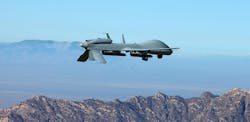General Atomics to build long-range unmanned aircraft with an open-systems architecture for reconnaissance
REDSTONE ARSENAL, Ala. – U.S. Army unmanned aircraft experts are asking General Atomics Aeronautics Systems Inc. in Poway, Calif., to build MQ-1C-25M Gray Eagle modernized extended-range unmanned aerial vehicles (UAVs) under terms of a $389 million one-year contract announced on Friday.
Officials of the Army Contracting Command at Redstone Arsenal, Ala., are asking General Atomics for MQ-1C-25M UAVs for multi-domain operations.
The MQ-1C-25M is the latest version of the MQ-1C Gray Eagle, and is multi-mission, medium-altitude, long-endurance unmanned aircraft for real-time artillery spotting and targeting; and intelligence, surveillance, target acquisition, and reconnaissance.
The Army operates the Gray Eagle in each of its 11 Combat Aviation Brigades. The Gray Eagle 25M variant adds an open systems architecture, upgraded sensors, and new communications links.
Related: SOSA and open standards for military embedded computing
The Gray Eagle 25M new communications links will include over-the-horizon Ku and Ka-band satellite communications, Link 16, and software-defined ultra-high frequency and very high frequency communication links.
The unmanned aircraft will carry the Eagle Eye radar to detect and track moving targets on land or at sea. It also can have other sensors because of its open-systems architecture.
The new variant also includes a 200 horsepower heavy-fuel engine to improve electrical power by about 50 percent. The Gray Eagle 25M is the latest version of the The General Atomics MQ-1C Gray Eagle attack drone medium altitude long endurance unmanned aircraft, which is an upgraded MQ-1 Predator. The aircraft can be fitted with the AGM-114 Hellfire missile or GBU-44/B Viper Strike guided bomb for attack missions.
The Gray Eagle UAV has a synthetic aperture radar and ground moving target indicator (SAR-GMTI) system, and targeting capability from an AN/AAS-52 multi-spectral targeting system (MTS) under the nose. The aircraft can carry a payload as heavy as 800 pounds.
Related: The sensor- and signal-processing challenges of electronic warfare
The MQ-1C Gray Eagle provides reconnaissance, surveillance, and target acquisition; command and control; communications relay; signals intelligence; electronic warfare; attack; detection of weapons of mass destruction; battle damage assessment; and manned and unmanned teaming capabilities.
Compared with its MQ-1 Predator predecessor, the Gray Eagle has an increased wingspan, and a Thielert Centurion 1.7 heavy-fuel engine (HFE) able to burn jet and diesel fuel. The UAV can fly for as long as 36 hours at altitudes to 25,000 feet. It has an operating range of 200 nautical miles.
Army commanders deploy the Gray Eagle UAV in platoons, each with four aircraft, support equipment, and payloads like electro-optical/infrared/laser range finder/laser designator; communications relay; and as many as four hellfire missiles. The common sensor payload and synthetic aperture radar ground moving target indicator are one per aircraft. Ground equipment per platoon includes two universal ground control stations; three universal ground data terminals; one satellite communication ground data terminal; and one mobile ground control station per company.
On this contract General Atomics do the work at locations to be determined with each order, and should be finished by November 2024. For more information contact General Atomics Aeronautical Systems online at www.ga-asi.com, or the Army Contracting Command-Redstone at https://acc.army.mil/contractingcenters/acc-rsa/.

